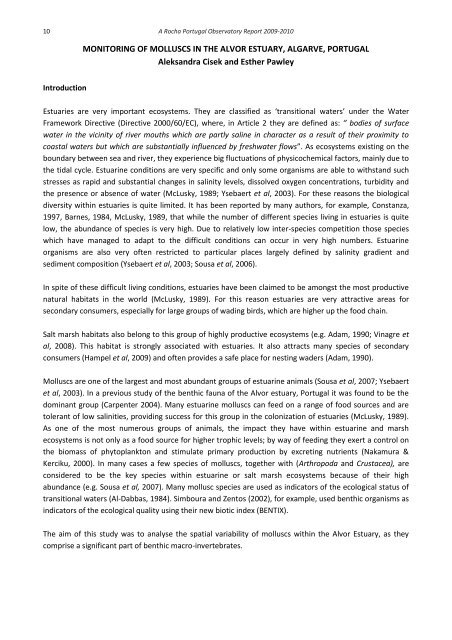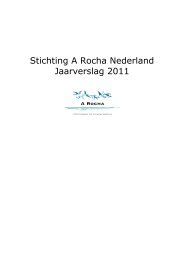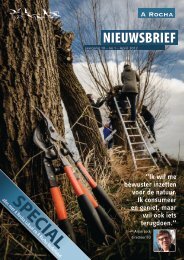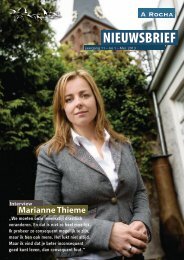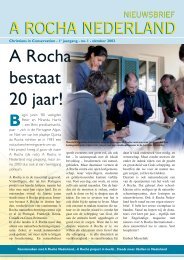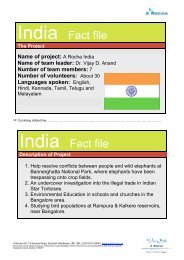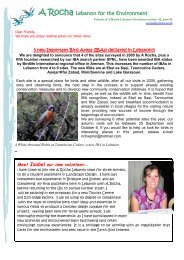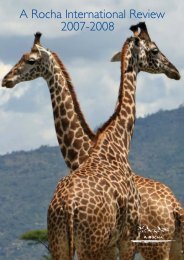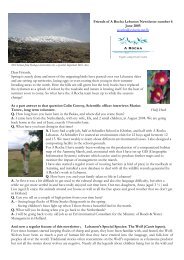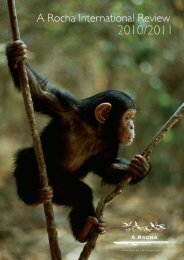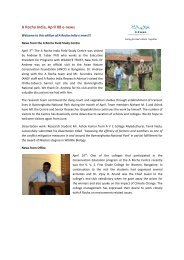A Rocha Portugal Observatory Report 2009-2010
A Rocha Portugal Observatory Report 2009-2010
A Rocha Portugal Observatory Report 2009-2010
You also want an ePaper? Increase the reach of your titles
YUMPU automatically turns print PDFs into web optimized ePapers that Google loves.
10 A <strong>Rocha</strong> <strong>Portugal</strong> <strong>Observatory</strong> <strong>Report</strong> <strong>2009</strong>-<strong>2010</strong><br />
Introduction<br />
MONITORING OF MOLLUSCS IN THE ALVOR ESTUARY, ALGARVE, PORTUGAL<br />
Aleksandra Cisek and Esther Pawley<br />
Estuaries are very important ecosystems. They are classified as ‘transitional waters’ under the Water<br />
Framework Directive (Directive 2000/60/EC), where, in Article 2 they are defined as: ” bodies of surface<br />
water in the vicinity of river mouths which are partly saline in character as a result of their proximity to<br />
coastal waters but which are substantially influenced by freshwater flows”. As ecosystems existing on the<br />
boundary between sea and river, they experience big fluctuations of physicochemical factors, mainly due to<br />
the tidal cycle. Estuarine conditions are very specific and only some organisms are able to withstand such<br />
stresses as rapid and substantial changes in salinity levels, dissolved oxygen concentrations, turbidity and<br />
the presence or absence of water (McLusky, 1989; Ysebaert et al, 2003). For these reasons the biological<br />
diversity within estuaries is quite limited. It has been reported by many authors, for example, Constanza,<br />
1997, Barnes, 1984, McLusky, 1989, that while the number of different species living in estuaries is quite<br />
low, the abundance of species is very high. Due to relatively low inter-species competition those species<br />
which have managed to adapt to the difficult conditions can occur in very high numbers. Estuarine<br />
organisms are also very often restricted to particular places largely defined by salinity gradient and<br />
sediment composition (Ysebaert et al, 2003; Sousa et al, 2006).<br />
In spite of these difficult living conditions, estuaries have been claimed to be amongst the most productive<br />
natural habitats in the world (McLusky, 1989). For this reason estuaries are very attractive areas for<br />
secondary consumers, especially for large groups of wading birds, which are higher up the food chain.<br />
Salt marsh habitats also belong to this group of highly productive ecosystems (e.g. Adam, 1990; Vinagre et<br />
al, 2008). This habitat is strongly associated with estuaries. It also attracts many species of secondary<br />
consumers (Hampel et al, <strong>2009</strong>) and often provides a safe place for nesting waders (Adam, 1990).<br />
Molluscs are one of the largest and most abundant groups of estuarine animals (Sousa et al, 2007; Ysebaert<br />
et al, 2003). In a previous study of the benthic fauna of the Alvor estuary, <strong>Portugal</strong> it was found to be the<br />
dominant group (Carpenter 2004). Many estuarine molluscs can feed on a range of food sources and are<br />
tolerant of low salinities, providing success for this group in the colonization of estuaries (McLusky, 1989).<br />
As one of the most numerous groups of animals, the impact they have within estuarine and marsh<br />
ecosystems is not only as a food source for higher trophic levels; by way of feeding they exert a control on<br />
the biomass of phytoplankton and stimulate primary production by excreting nutrients (Nakamura &<br />
Kerciku, 2000). In many cases a few species of molluscs, together with (Arthropoda and Crustacea), are<br />
considered to be the key species within estuarine or salt marsh ecosystems because of their high<br />
abundance (e.g. Sousa et al, 2007). Many mollusc species are used as indicators of the ecological status of<br />
transitional waters (Al-Dabbas, 1984). Simboura and Zentos (2002), for example, used benthic organisms as<br />
indicators of the ecological quality using their new biotic index (BENTIX).<br />
The aim of this study was to analyse the spatial variability of molluscs within the Alvor Estuary, as they<br />
comprise a significant part of benthic macro-invertebrates.


